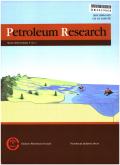Combined mechanistic and machine learning method for construction of oil reservoir permeability map consistent with well test measurements
IF 4
Q1 Earth and Planetary Sciences
引用次数: 0
Abstract
We introduce a novel method for estimating the spatial distribution of absolute permeability in oil reservoirs, consistent with well logging and well test measurements. The primary objective is to create a permeability map, incorporating the well test interpretation results and achieving hydrodynamic similarity to the actual permeability distribution around each well. This enhancement aims to improve the accuracy of reservoir modeling outcomes in reproducing real data. We utilize Nadaraya-Watson kernel regression to parameterize the two-dimensional spatial distribution of rock permeability. The kernel regression parameters are optimized by minimizing the discrepancies between actual and predicted values of permeability at well locations, the integral permeability of the reservoir domain around each well, and skin factors. This inverse optimization problem is addressed by repeatedly solving forward problems, where an artificial neural network (ANN) predicts the integral permeability of the formation surrounding a well and skin factor. The ANN is trained on a physics-based dataset generated through a synthetic well test procedure, which includes the numerical modeling of the bottomhole pressure decline curve in a reservoir simulator and its interpretation using a semi-analytical reservoir model. The proposed method is tested on the “Egg Model”, a synthetic reservoir with significant heterogeneity due to highly permeable channels. The permeability map created by our approach demonstrates hydrodynamic similarity to the original map. Numerical reservoir simulations, corresponding to the constructed and original permeability maps, yield comparable pore pressure and water saturation distributions at the end of the simulation period. Additionally, we observe a notable match in flow rates and total volumes of produced oil, water, and injected water between simulations. The developed approach outperforms kriging in terms of numerical reservoir modeling outcomes. This research advances existing geostatistical interpolation techniques by fusing well logging and well test data to build the reservoir permeability map through an optimization framework coupled with machine learning. Unlike traditional variogram-based geostatistical simulation algorithms, our method provides a permeability distribution that is hydrodynamically similar to the actual one, enhancing initial guess in the history matching process. The novel incorporation of well test interpretation results into the permeability map represents a significant improvement over existing methods, offering an innovative approach that can benefit the petroleum industry. We also provide recommendations for further development of the proposed algorithm to account for geological realism.
基于机械与机器学习相结合的试井油藏渗透率图构建方法
本文介绍了一种估算油藏绝对渗透率空间分布的新方法,该方法与测井和试井测量结果一致。主要目标是创建渗透率图,结合试井解释结果,并实现与每口井周围实际渗透率分布的流体动力学相似性。这种增强旨在提高再现真实数据时油藏建模结果的准确性。利用Nadaraya-Watson核回归对岩石渗透率的二维空间分布进行参数化。通过最小化井位渗透率的实际值与预测值之间的差异、每口井周围储层区域的整体渗透率以及表皮因素,优化了核回归参数。这种逆向优化问题通过反复求解正演问题来解决,其中人工神经网络(ANN)预测井周围地层的整体渗透率和表皮因子。人工神经网络是在通过综合试井程序生成的基于物理的数据集上进行训练的,其中包括油藏模拟器中井底压力下降曲线的数值模拟,以及使用半解析油藏模型对其进行解释。该方法在“鸡蛋模型”上进行了测试,“鸡蛋模型”是一种由于高渗透通道而具有显著非均质性的合成储层。通过我们的方法生成的渗透率图与原始图具有水动力相似性。数值油藏模拟,对应于构建的渗透率图和原始渗透率图,在模拟期结束时得出了相似的孔隙压力和含水饱和度分布。此外,我们观察到两次模拟之间的流量和采出油、水和注入水的总量有显著的匹配。该方法在油藏数值模拟结果方面优于克里格法。该研究通过结合机器学习的优化框架,将测井和试井数据融合在一起,构建储层渗透率图,从而改进了现有的地质统计学插值技术。与传统的基于变异函数的地质统计模拟算法不同,该方法提供了与实际渗透率分布流体动力学相似的渗透率分布,增强了历史匹配过程中的初始猜测。将试井解释结果整合到渗透率图中是对现有方法的重大改进,提供了一种创新的方法,可以使石油工业受益。我们还为进一步发展所提出的算法提供建议,以考虑地质真实性。
本文章由计算机程序翻译,如有差异,请以英文原文为准。
求助全文
约1分钟内获得全文
求助全文
来源期刊

Petroleum Research
Earth and Planetary Sciences-Geology
CiteScore
7.10
自引率
0.00%
发文量
90
审稿时长
35 weeks
 求助内容:
求助内容: 应助结果提醒方式:
应助结果提醒方式:


